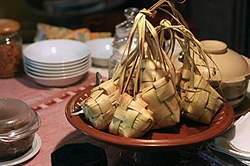Ketupat

Unopened bunch of cooked ketupat on a plate.
|
|
| Alternative names | Kupat, tupat, topat, tipat, patupat, bugnóy, pusô, piyoso, ta’mu |
|---|---|
| Course | Main course |
| Serving temperature | Hot or room temperature |
| Main ingredients | Rice cooked inside of pouch made from woven young palm leaves |
| Variations | Ketupat pulut, ketupat daun palas, lepet |
| 1 bowl of ketupat sayur has approximately 93 kcal | |
| |
|
Ketupat (in Indonesian and Malaysian), Kupat (in Javanese and Sundanese) or Tipat (in Balinese) is a type of dumpling made from rice packed inside a diamond-shaped container of woven palm leaf pouch. It is commonly found in Brunei, Singapore, Malaysia, Indonesia and Philippines (where it is known by the name piyoso in Maranao, Iranun and Maguindanaon, ta’mu in Tausug, bugnóy in Hiligaynon, pusô in Cebuano and patupat in Kapampangan, Pangasinan and Ilocano). It is commonly described as "packed rice", although there are other types of similar packed rices such as lontong and bakchang.
Ketupat is cut open, its skin (woven palm leaf) being removed, the inner rice cake is cut in pieces, and served as staple food, as the replacement of plain steamed rice. It usually eaten with rendang, opor ayam, sayur labu (chayote soup), sambal goreng hati (liver in sambal) or served as an accompaniment to satay (chicken or beef or lamb in skewers) or gado-gado (mixed vegetables with peanut sauce). Ketupat is also the main element of certain dishes such as ketupat sayur (ketupat in chayote soup with tofu and boiled egg) and kupat tahu (ketupat and tofu in peanut sauce).
...
Wikipedia
